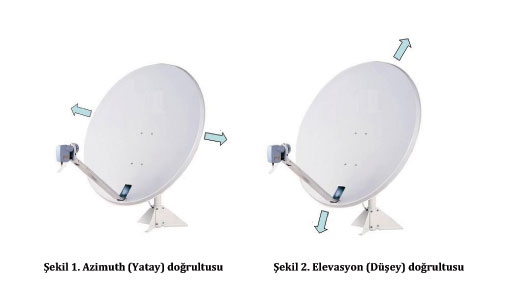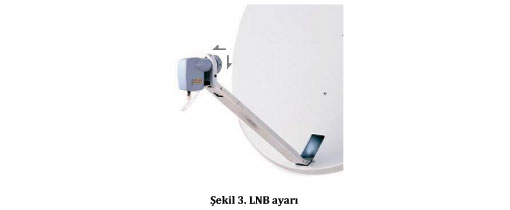A receiver antenna, an LNB and a satellite receiver are used to watch satellite broadcasts. Watching broadcasts trouble-free is possible only if the antenna is focused exactly to the satellite. Therefore, antenna must be installed by service professionals having sufficient technical knowledge and hardware. How an satellite antenna alignment can be checked and corrected without using any equipment will be clarified here.
Antenna alignment is made by moving the receiving antenna in the azimuth (left-right) and elevation (up-down) directions.

While aligning the receiving antenna, the level of a weak broadcast signal of the satellite is taken into consideration. The signal level of the channel is followed by pressing the info of key of the controller. As a result of the movement in the specified direction, the highest signal level in that direction is found, so that the most convenient point in the relevant direction is determined for the antenna. The same procedure is held for the other direction and the highest level as well as the most convenient point in the relevant direction is found once again. So, the receiving antenna is become directed properly to the satellite. During these alignments, the screws used for fixing the antenna for each direction must be loosened and tightened back carefully without losing the strong signal obtained when the setup is over.
Caution: Before starting the alignment procedure, the horizontal and vertical position of the antenna must be marked with a pen in order not to lose the existing position of the satellite antenna. Thus, it would be possible to return to the starting point if the satellite signal is lost.
Caution: In order to align the antenna precisely, the movements in the horizontal and vertical directions must be as small as possible.
The next step is aligning the LNB (without moving the antenna dish) in order to fit the receiving mechanism into the satellite polarization In order to do this, a low strength specimen on the direction of any broadcast (for example horizontal) is chosen and the quality and level of the signal is checked. The level of the broadcast is followed by pressing the info of key of the controller. The LNB on the receiving focus of the antenna is rotated clockwise or counterclockwise while keeping the antenna fixed, so that the point where the level is maximum is determined.

Thus, the antenna and LNB become aligned precisely.
Every LNB strengthens the received satellite signals and conducts a frequency conversion, and reduces the high-frequency satellite signals to low frequencies. The LNB mounted on the satellite antenna may lose its features in time because of various environmental conditions. Such an LNB may convert the frequency into a value a few MHz lower or higher than it should be. Such a situation may cause inability to display some channels even if the antenna is aligned properly. In case of a problem like this, the best thing to do is to replace the LNB. However, the following temporary solution can be used to overcome the problem until the LNB is replaced. All parameters of the broadcast are entered manually into the search menu of the receiver. When the receiver encodes the broadcast, the signal quality is noted before pressing the OK button. The entered frequency is increased by 1 MHz. The signal level is re-checked at this frequency change; if the level is decreased, then the frequency value is decreased. If there is a level increase in this direction, the entered frequency is decreased by 1 MHz. The point where the signal level is maximal is found and this frequency is used for the broadcast. In other words, the frequency is increased and decreased by 1 MHz at a time from the value it should be, and the point where the strongest signal is received is determined.
The cable connecting the antenna mechanism to the satellite receiver must be as short and good-quality as possible. As the cable gets longer, the strength of the signal reaching the satellite receiver gets weaker. If a very long cable is needed, a line amplifier can be used to amplify the signal level before the satellite receiver. Low quality cables may cause some problems such as too much attenuation of the signal and influence by various environmental factors like wireless telephones. Satellite receivers are unable to encode signals below a certain threshold.
The noise insulation of tuner layers of some satellite receivers may be weak. In such a case, the satellite receiver can easily be exposed to environmental impacts. When problems such as inability to receive some broadcasts particularly in old satellite receivers, it may be necessary to make a software update.
Careful selection of all equipments to be used in a satellite receiving system in accordance with the foregoing cautions is important to watch the satellite broadcasts smoothly for many years.
Caution: The list of frequencies of the TV/Radio broadcasts of Türksat satellites can be found in Türksat web site or in the subtitle or teletext features of Türksat introduction broadcast.
Türksat Introduction Broadcast Parameters:
- F:12380 Pol: V Dikey, SR:27500, FEC: 3/4 (Europe and Turkey)
- F:12423 Pol: H Yatay, SR:30000, FEC: 3/4 (Central Asia and Turkey)
For an automatic update of satellite receivers according to Türksat TV/Radio broadcasts, the parameters of Türksat Introduction broadcast must be entered manually and the network search feature must be activated so as to start the search.
| Attachment | Size |
|---|---|
| Antenna Alignment Document | 166.57 KB |